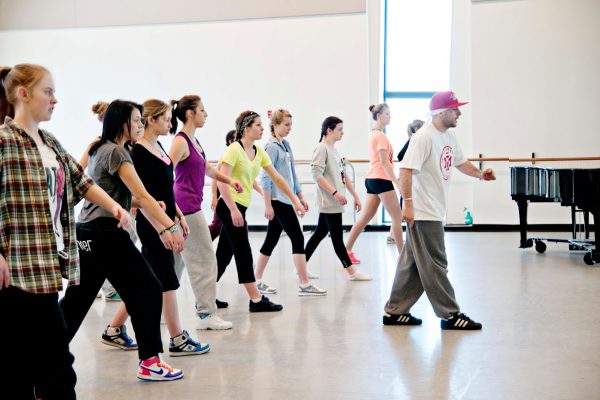Great dancers are like gemstones. Fully experiencing their brilliance can depend on the sensitivity and fit of the setting they’ve been given by the choreographer, composer, set designer etc. When everything is up to the standard such artists can inspire, excitement ensues; mess up with the setting and it feels like a crime against art. And then theres everything that can happen between these two poles.
This concept was amply demonstrated at the recently concluded Canasian Dance Festival, at least in Mainstage Program B, which is the only one I was able to see. The brainchild of Denise Fujiwara, who remains its artistic director, the Festival takes place every two years and offers a shining array of traditional and contemporary works rooted in Asian cultures. Program B included two world premieres, a Toronto premiere and a commissioned work. World premieres first.
“Berdandan” is an Indonesian word meaning grooming, personal embellishment or dressing up. Peter Chin’s new work of the same name makes an elaborate stage piece out of exactly that. Chin has created a fascinating setting for the jewel of a classical Javanese dance, performed by virtuoso performer Didik Nini Thowok. Chin has assembled what seems like a cast of thousands — Gamelan Toronto, with their splendid instruments, sit onstage next to a stylized dressing room. A veiled screen receives live close-up video images generated by photographer Cylla von Tiedemann, also onstage. The character of a dresser (played by Yves Candeau) translates the story of a male dancer who performs as a woman. At the same time, he assists Didik in donning an elaborate and beautiful costume with yards of brocaded silk, gold jewellery and a spectacular headdress. Once the transformation is complete, the dance begins. Vocals and the gong-like rhythms of the gamelan accompany this stately yet sensual dance of hyper-extended wrists and fingers. What initially seemed a bit messy in terms of multimedia stage business now proves to be a nice foil for the delicate precision of Didik’s elegant movement phrases.
Festival director Denise Fujiwara also unveiled a world premiere. Hers was a solo, entitled “Late Fall”, which she performed to a score by Toru Takemitsu played live on violin and piano by Mayumi Seiler and Vadim Serebryanay respectively.
It’s a tense inward-looking dance — Fujiwaras cardigan and skirt and some dappled lighting effects by Roelof Peter Snippe evoke some kind of autumn of the soul, chill, lonely, huddled. But the narrative is never overt and Fujiwaras dance leaves only the slightest of impressions. In trying to convey secrets, shes ended up being obscure. Still — she’s a compelling performer with veteran chops and watching her butoh-slow insularity is never unpleasant.
Much more fun and equally mysterious is “Ha-Su — breath of lotus flower”, the real deal Butoh offering from Japan’s Fisherman’s Art Factory Yan-Shu. The company is directed by Kinya Zulu Tsuruyama and he is the centerpiece of the dance, surrounded by three bare-torsoed acolytes with red glyphs painted on their backs. These sidekicks stole the show for me. Though they all look the part of practitioners of the notoriously humourless and slow-moving form that was born in the aftermath of Hiroshima and Nagasaki — their heads are shaved and their skin painted white — these three stooges move fast on occasion with manic power. They are also mischievous rather than simply suffering and the facial mugging they perform in a band of light close to the lip of the stage is deliciously creepy and riveting. What Yan Shu is trying to convey is anyones guess. There is the usual Japanese verse printed in the program — something about breathing, moonlight on water and the flower in the mud. But here obscurity doesnt seem to matter; life is supposed to be incomprehensible at times and we must dig for the meaning behind the imagery. And just as an aside, to return to our topic of settings, someone should tell Kinya Tsuruyama that he’s being shamelessly upstaged.
This fate will likely never befall Canadian dancer Natasha Bakht. Whenever I watch her perform as part of an ensemble (Bakht has performed in companies with Menaka Thakkar, Roger Sinha and Shobana Jeyasingh), I just wish everyone would get out of her way. So I was definitely looking forward to “Triptych Self”, a solo commissioned by the Festival especially for Bakht and choreographed by London’s classical South Asian fusionist Jeyasingh.
As suggested by the title, the dance has three parts. A musical score featuring spoken words laid over various rhythms and counter-rhythms is a fascinating yet not altogether successful connecting device. At times it distracts from the liquid silver created by Bakht in her non-stop movement sequences. Some of the arm, hand and head gestures seem familiar, referencing the classical idiom of bharata natyam. But Jeyasingh and Bakht take them out of context, using them almost as connecting pieces between more contemporary phrases. At a certain point, the barrage becomes overbearing. How long, the watcher wonders, can this perfect dancer continue these perfectly executed steps at this pace? Well, for a long time apparently — when the curtain comes down Bakht seems to have barely broken a sweat. It makes you wonder whether Jeyasingh hasnt underestimated Bakht, casting a spotlight on her physical virtuosity but revealing little about the rest of the woman — her intelligence, her internal life. “Triptych Self” uncovers facets of a beautiful human machine rather than fully portraying a remarkable woman in all her glory. Here we had a brilliant diamond in a setting that didnt do it justice.
Tagged: Asian, Contemporary, Festival, Performance, ON , Toronto





